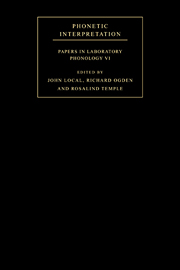Book contents
- Frontmatter
- Contents
- List of contributors
- Acknowledgements
- Introduction
- Part I Phonological representations and the lexicon
- Part II Phonetic interpretation and phrasal structure
- Part III Phonetic interpretation and syllable structure
- 11 On the factorability of phonological units in speech perception
- 12 Articulatory correlates of ambisyllabicity in English glides and liquids
- 13 Extrinsic phonetic interpretation: spectral variation in English liquids
- 14 Temporal constraints and characterising syllable structuring
- 15 Commentary: some thoughts on syllables: an old-fashioned interlude
- Part IV Phonology and natural speech production: tasks, contrasts and explanations
- References
- Index of names
- Index of subjects
12 - Articulatory correlates of ambisyllabicity in English glides and liquids
Published online by Cambridge University Press: 22 September 2009
- Frontmatter
- Contents
- List of contributors
- Acknowledgements
- Introduction
- Part I Phonological representations and the lexicon
- Part II Phonetic interpretation and phrasal structure
- Part III Phonetic interpretation and syllable structure
- 11 On the factorability of phonological units in speech perception
- 12 Articulatory correlates of ambisyllabicity in English glides and liquids
- 13 Extrinsic phonetic interpretation: spectral variation in English liquids
- 14 Temporal constraints and characterising syllable structuring
- 15 Commentary: some thoughts on syllables: an old-fashioned interlude
- Part IV Phonology and natural speech production: tasks, contrasts and explanations
- References
- Index of names
- Index of subjects
Summary
Introduction
In a previous volume of this series, Turk (1994: 107) states that ‘it is widely assumed that word-initial and word-final consonants are syllable-initial and syllable-final respectively’. However, phonological evidence abounds for complete or partial ‘resyllabification’ of word-final consonants across word boundaries. Examples of this include such well-known cases as alveolar ‘flapping’ (Kahn 1976), linking r (McMahon, Foulkes and Tollfree 1994), linking l (Gick forthcoming) and glide formation (Broadbent 1991, Harris 1994), or ‘linking’ (Whorf 1943). In all of these cases, when it is followed by a vowel-initial word, a final segment adopts characteristics associated either with initial allophones or with word-internal allophones of the variety often referred to as ‘ambisyllabic’ (Kahn 1976). Acoustic and articulatory studies of English /l/ (Bladon and Al-Bamerni 1976; Sproat and Fujimura 1993) and /r/ (Gick forthcoming) support this view of word-final consonants.
In recent years, researchers have begun using articulatory measures such as gestural timing and magnitude in an attempt to identify the general phonetic correlates of various syllable positions (Krakow 1989; Browman and Goldstein 1992, 1995; Sproat and Fujimura 1993; Wang 1995; see Turk 1994: 113 for earlier citations). The applicability of a gestural approach to the phonological modelling of the syllable would be greatly enhanced if it could be shown that these same correlates can also encompass traditional resyllabification phenomena in English.
- Type
- Chapter
- Information
- Phonetic InterpretationPapers in Laboratory Phonology VI, pp. 222 - 236Publisher: Cambridge University PressPrint publication year: 2004



